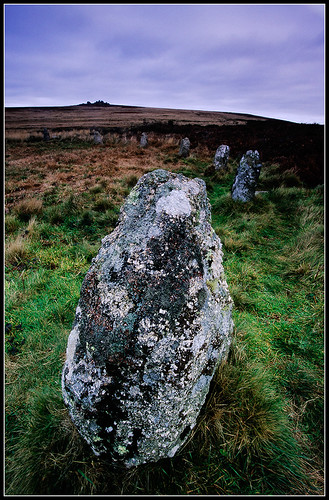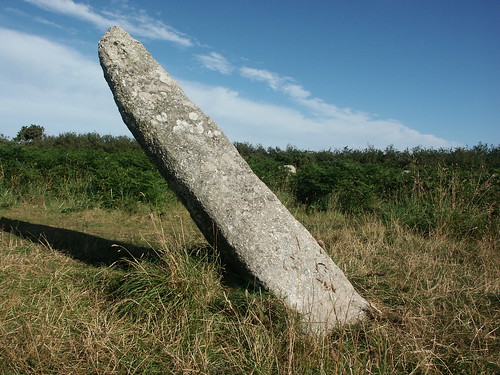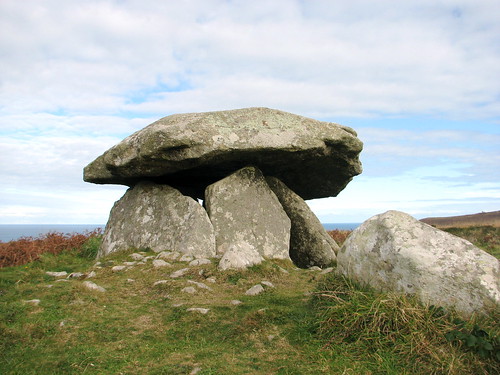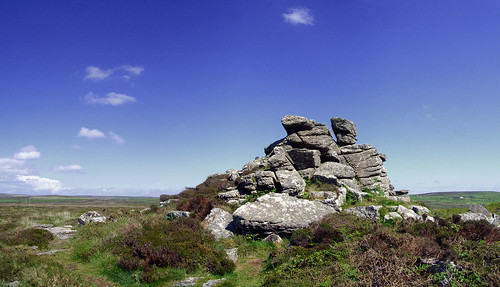This unique balance is demonstrated in two ways. West Penwith is certainly in line for the distinction of being on the World Heritage List and it is also the site of many ongoing research projects involving the ancient sites and megalithic stones in the area.
Astronomy
At the turn of the twentieth century, Sir Norman Lockyer chose the megaliths of West Penwith as one of his study areas while developing his work on archaeo-astronomy.
Astronomy
At the turn of the twentieth century, Sir Norman Lockyer chose the megaliths of West Penwith as one of his study areas while developing his work on archaeo-astronomy.

He observed that from the Tregeseal stone circle (pictured above), the May Day sun rise could be seen rising behind a tall standing stone called the Longstone, who's tip is visible because it juts up from behind a ridge to the northeast of the site.
In recent times, researchers have directly witnessed unsuspected astronomical events at West Penwith sites. The peninsula's best preserved stone circle is Boscawen-un and has a leaning pillar stone set off center within the ring.

It points to the northeast and is confirmed that it indicate the rising midsummer sun when viewed from its base. Faint axe head carvings on the stone are thrown into strongest relief by the lighting of that particular sunrise. One of the 19 stones is a pure quartz stone that is named the moon stone, probably because of the facts that it seems to almost glow in the moonlight.
Another example of modern astronomical discovery involves the Neolithic stone chamber or dolmen of Chun Quoit.
Another example of modern astronomical discovery involves the Neolithic stone chamber or dolmen of Chun Quoit.

Chun Quoit is an isolated monument on a broad expanse of high moorland. It is situated exactly in the right position for the midwinter sun to appear to set into a notch on a natural outcrop called Kenidjack (below), which stands prominently on the southwestern skyline as viewed from the Chun Quoit dolmen (above).

Geomancy and Earth Energies
In 1974, John Michell published one of the best regional studies of Ley type alignment. In his book, The Old Stones of Land's End, he took Lockyer's original Penwith astronomical sight lines and the best archaeological catalogue of sites and checked for alignments. What he found was astounding.
As it turned out, nearly all of the menhirs, stone circles and dolmens were on one or more alignments that were always perfectly accurate. Some were astronomical, but most were not.
He also discovered that each site in the line could be seen by the one before and it could see the next one in line. These sites were carefully spaced at a distance from one another that would facilitate just barely being able to see the next site in line, right at the point of the furthest distance of visibility.
This type of placement is common in almost all ley lines of the world. This kind of sentinel stone placement also accounts for the origin of steeples in churches. The steeples would serve as a guide for travelers who journeyed from one monastery to the next as they traveled towards their final destinations.
As it turned out, nearly all of the menhirs, stone circles and dolmens were on one or more alignments that were always perfectly accurate. Some were astronomical, but most were not.
He also discovered that each site in the line could be seen by the one before and it could see the next one in line. These sites were carefully spaced at a distance from one another that would facilitate just barely being able to see the next site in line, right at the point of the furthest distance of visibility.
This type of placement is common in almost all ley lines of the world. This kind of sentinel stone placement also accounts for the origin of steeples in churches. The steeples would serve as a guide for travelers who journeyed from one monastery to the next as they traveled towards their final destinations.

Strange lights are often seen near the entrance to Boleigh Forou. Boleigh Forou is an Iron Age subterranean chamber that is often bathed with tiny pricks of light, like stars, and thin spiral filaments moving over the interior granite surfaces of the chamber. Inside the granite Chun Quoit dolmen, archaeologist John Barnatt and photographer Brian Larkmans saw periodic short bursts of light flashing across the underside of the cap stone.
West Penwith is primarily granite country and so background radiation levels are relatively high. Inside enclosed granite structures like dolmens and fogous, the ambient radioactivity is heightened. This could even account for the fairy sightings that were often noted through the centuries.
In fact, Geiger readings taken as part of the Dragon Project are directly comparable to those obtained from inside the granite clad King's Chamber in the Great Pyramid of Giza.
West Penwith is primarily granite country and so background radiation levels are relatively high. Inside enclosed granite structures like dolmens and fogous, the ambient radioactivity is heightened. This could even account for the fairy sightings that were often noted through the centuries.
In fact, Geiger readings taken as part of the Dragon Project are directly comparable to those obtained from inside the granite clad King's Chamber in the Great Pyramid of Giza.

The highest readings were found on the water surface at the Sancreed Holy Well (above), where the waters rise into a roughly hewn stone reservoir in a subterranean stone chamber. Many believe that the Sancreed well defines the personality, and is the spiritual center, of West Penwith.
Many people have noticed a sense of languor at this truly sacred spot and it has been suggested that heightened natural radiation can perhaps engender this feeling. It is a known fact that the Earth naturally resonates at a frequency of about 7.8 hertz that is known as the Schuman Resonance.
Many people have noticed a sense of languor at this truly sacred spot and it has been suggested that heightened natural radiation can perhaps engender this feeling. It is a known fact that the Earth naturally resonates at a frequency of about 7.8 hertz that is known as the Schuman Resonance.






0 comments:
Post a Comment